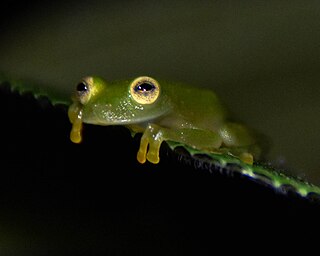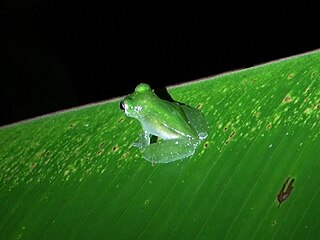
The glass frogs belong to the amphibian family Centrolenidae. While the general background coloration of most glass frogs is primarily lime green, the abdominal skin of some members of this family is transparent and translucent, giving the glass frog its common name. The internal viscera, including the heart, liver, and gastrointestinal tract, are visible through the skin. When active their blood makes them visible; when sleeping most of the blood is concealed in the liver, hiding them. Glass frogs are arboreal, living mainly in trees, and only come out for mating season. Their transparency conceals them very effectively when sleeping on a green leaf, as they habitually do.

Cochranella is a genus of glass frogs, family Centrolenidae. They are found in Central America from Honduras southward to the Amazonian and Andean cloud forests of Colombia, Ecuador, Peru, and Bolivia.

Hyalinobatrachium is a genus of glass frogs, family Centrolenidae. They are widely distributed in the Americas, from tropical Mexico to southeastern Brazil and Argentina.

Cochranella nola is a species of frog in the family Centrolenidae, the glass frogs, so named because of the transparent skin on the underside of the abdomen through which the internal organs can be seen. This species is endemic to Bolivia where it is found in the Andean foothills in the Santa Cruz Department. Its natural habitats are subtropical or tropical moist montane forests and rivers. The scientific name nola is Latin for "small bell", and refers to the high-pitched, bell-like call of the male in the breeding season.
Hyalinobatrachium aureoguttatum, also known as the Atrato Glass Frog and Sun Glassfrog, is a species of frog in the family Centrolenidae. It is found in northern Ecuador, Pacific lowlands and western slopes of the Cordillera Occidental in Colombia, and eastern Panama. It occurs from near sea level to 1,560 m (5,120 ft) asl.

Hyalinobatrachium chirripoi is a species of frog in the family Centrolenidae. It is found in extreme northern Ecuador, northwestern Colombia, Panama, and Costa Rica, as well as in Honduras. The specific name chirripoi refers to the Chirripó Indians inhabiting the area of the type locality, Suretka in the Talamanca canton of Costa Rica. Common name Suretka glass frog has been coined for it.

Hyalinobatrachium fleischmanni, also known as Fleischmann's glass frog or the northern glass frog, is a species of frog in the family Centrolenidae. It is found in the tropical Americas from southern Mexico to Ecuador. Specifically, these frogs occur in Mexico, Belize, Costa Rica, El Salvador, Guatemala, Honduras, Nicaragua, and Panama, Colombia, and Ecuador. Notice that this and related species have often been confused with each other, and the exact distribution depends on the source. This frog tends to have green skin, pale yellowish spots, yellow fingertips and translucent skin covering its stomach.

Hyalinobatrachium iaspidiense is a species of frog in the family Centrolenidae from South America. Its specific name refers Quebrada de Jaspe, its type locality.
Hyalinobatrachium orientale is a species of glass frog in the family Centrolenidae. It is found on the island of Tobago and in eastern Venezuela. Its common name is eastern glass frog. The Tobagonian population has been described as subspecies Hyalinobatrachium orientalis tobagoensis(Hardy, 1984). The latter is sometimes referred to as Tobago glass frog. H. orientale is distributed throughout the Central Eastern ranges of the Cordillera de la Costa in Venezuela and Tobago Island with an altitudinal range of 190 to 1200 meters.

Hyalinobatrachium pellucidum, also known as the Rio Azuela glass frog, is a species of frog in the family Centrolenidae. It is found in lower montane rainforests on the Amazonian Andean slopes in Ecuador and Peru. The specific name pellucidum is Latin for "transparent" and refers to the transparent parietal peritoneum of this species.

The powdered glass frog or Chiriqui glass frog is a frog species in the glass frog family (Centrolenidae). The species is found from north-central Honduras south to northwestern Ecuador.

Hyalinobatrachium valerioi, sometimes known as the La Palma glass frog, is a species of frog in the family Centrolenidae. It is found in central Costa Rica and south to Panama and the Pacific lowlands and slopes of western Colombia and Ecuador; also in the Magdalena River Valley of Colombia.

Hyalinobatrachium vireovittatum is a species of frog in the family Centrolenidae. It is found in scattered localities in Costa Rica and west-central Panama. It has, however, been suggested that most populations actually represent Hyalinobatrachium talamancae, with Hyalinobatrachium vireovittatum restricted to its type locality in the San Isidro de El General district.

Centrolene savagei is a species of frog in the family Centrolenidae that is endemic to the Andes of western Colombia, specifically the Cordillera Occidental and Cordillera Central. Its common name is Savage's Cochran frog.
Hyalinobatrachium dianae, also known as Diane's bare-hearted glass frog, is a species of Costa Rican glass frog in the family Centrolenidae.
Celsiella is a small genus of glass frogs endemic to Venezuela. It was established in 2009 and named in honour of Josefa Celsa Señaris, nicknamed "Celsi", a Venezuelan herpetologist who had worked with glass frogs.

Espadarana is a genus of glass frogs. They are found in Central America and northern South America.

Sachatamia is a small genus of glass frogs. They are found in Central America and northern South America at altitudes below 1,500 m (4,900 ft) above sea level.

Hyalinobatrachium yaku is a species of frog in the family Centrolenidae. It is found in the Pastaza, Orellana and Napo Provinces of Ecuador. One of the remarkable characteristics of this species is that their belly and some internal organs are transparent leaving the red heart completely exposed through transparent parietal peritoneum and pericardium. The glassfrogs are generally small, ranging from 0.8 to 3 inches (2-7.5 cm) in length. This species can be differentiated from other frogs in the Hyalinobatrachium genus by the row of dark green spots down the middle of its back.
Juan Manuel Guayasamin is an Ecuadorian biologist. He earned his Ph.D. in 2007 from University of Kansas, Department of Ecology and Evolutionary Biology and as of 2017 he is working as professor at Universidad San Francisco de Quito in Ecuador. His research interests include the evolution of glass frogs (Centrolenidae) and direct-developing anurans. His main contributions have been: phylogenetic taxonomy of glassfrogs, description of the variation of skin texture in frogs, description of numerous species of amphibians and reptiles, and a monographic review of all Ecuadorian glassfrogs. A team led by Juan M. Guayasamin discovered Hyalinobatrachium yaku in May 2017, a glassfrog with transparent venter. To date (2020), he has described a total of 6 amphibian genera, 55 species of amphibians, and 11 reptiles, including two geckos from the Galápagos Islands.

















